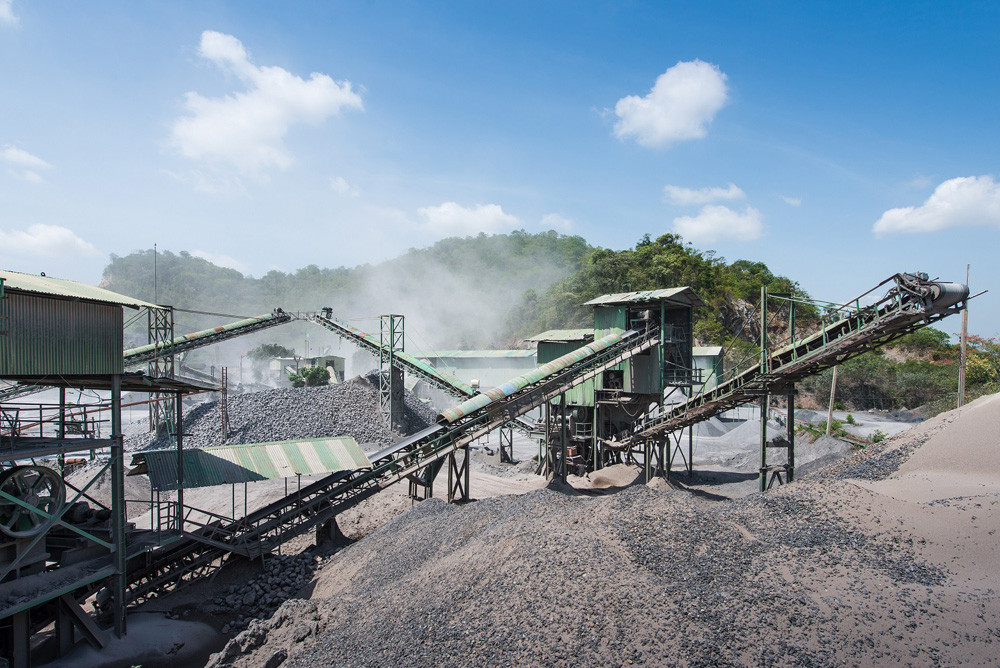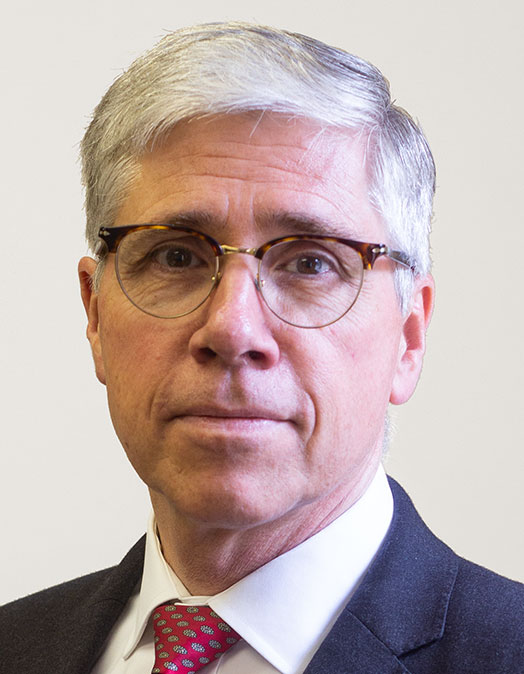
Cement and concrete production is highly energy intensive and the estimated four billion tonnes of cement produced a year is responsible for a massive 8% of global carbon dioxide (CO2) emissions, according to research by think tank Chatham House.
Concrete is the most widely used construction material in the world and production of the cement which is a main ingredient of concrete is a major contributor to climate change. The chemical and thermal combustion processes involved in cement production are a large source of CO2 emissions.

Ian Riley is CEO of the World Cement Association, having worked in the industry for many years including senior roles at LafargeHolcim, and is a prominent voice in how the cement sector can address the issue and achieve decarbonisation, which he identifies as the most important sustainability target for industry.
Riley says that 90% of cement is produced in developing countries, so to have a global solution to decarbonisation it is vital that any new technologies can be used across all types of markets worldwide.
He adds that there is still some space to improve with the traditional CO2 reduction levers that the cement industry has been using for many years such as fuel efficiency, changing to lower carbon fuels including waste, and reducing the clinker content in cement. But new and innovative solutions are also needed to reduce CO2 emissions to intermediate industry targets such as 30%, and ultimately to net zero carbon emissions.
One such technology that is gaining traction is LC3 (limestone calcined clay cement). LC3 cement is based on a blend of limestone and calcined clay and has been developed by Swiss academic institution École Polytechnique Fédérale de Lausanne (EPFL) with partners in India and Cuba. EPFL says that LC3 can reduce CO2 emissions by up to 40%, and that its ingredients are available in abundant quantities, meaning it is cost effective and does not require capital intensive modifications to existing cement plants.
“LC3 is the best example at the moment because it’s really hit the point where people are starting to use it, and it’s not a complicated technology,” says Riley.
“Calcined clay is something we have been using in cement for many years, as is ground limestone. The innovation with LC3 is that when used in the right ratio calcined clay plus limestone becomes a much better quality cementitious material and can be blended in larger amounts with clinker. LC3 is beginning to take off and we can see new plants being built that are using this technology. Initially the technology will develop in areas where it offers significant production cost savings.”
Companies that have built dedicated LC3 plants so far include mid-sized regional players such as Argos in Colombia and Cimpor. Portugal-based Cimpor has built a new plant in Ivory Coast, West Africa to produce LC3 with calcined clay from local deposits and imported clinker.
“I would say that the uptake is initially coming from mid-sized companies that are big enough to have some technical capability, and perhaps it’s a bit easier for them to move faster,” says Riley.
He predicts the global majors will start building LC3 plants in the next few years. Ideally LC3 plants need to be near a clay reserve to make the economics work.
In terms of continuing to use established methods of reducing carbon there is still is room to improve in areas such as cutting the amount of clinker used in making cement. Traditional OPC (ordinary Portland cement) is around 95% clinker. More than 50% of cement sector emissions are intrinsically linked to the process for producing clinker, according to the Chatham House report.
“Blended cements [such as LC3] can drop the clinker down to maybe 65% under current cement product standards,” says Riley. “With LC3 it is possible to make products that meet the application’s technical needs with lower clinker ratios, but this will require a change in product standards to accommodate these products. Beyond lower clinker factor, energy efficiency and fuel mix, we look at carbon capture as the next lever to reduce CO2 emissions, and either usage or storage.”
Carbon capture utilisation and storage (CCUS) is an integrated suite of technologies that has a proven 90% capture rate of the CO2 produced from the use of fossil fuels in electricity generation and industrial processes, preventing the CO2 from entering the atmosphere.
There are a number of CCUS initiatives being carried in Europe that are supported by governments. Of these, HeidelbergCement-owned Norcem’s project at its cement plant in Brevik is among the most advanced. With 400,000 tonnes of CO2 to be captured annually and transported for permanent storage, HeidelbergCement is planning for Brevik to become the first cement production facility globally to implement an industrial-scale carbon capture and storage (CCS) project.
Such CCS projects can require a large amount of capital outlay for infrastructure like pipelines, with the estimated cost of carbon capture at Brevik being around US$100 per tonne. For this reason Riley says more economical carbon capture and usage (CCU) initiatives may have greater potential for adoption worldwide.
“Ninety per cent of cement is used in the developing world, so something that increases the price of cement dramatically is probably not going to work in those countries,” he says. “I think carbon capture and storage will play some role, but possibly not a very large one. Carbon capture and usage has the potential to be more interesting and less expensive, because costs are potentially lower and you have some revenue.
“There are companies that are making artificial aggregates using CO2 and calcium-rich slurries, so this is one way. The quantities are tiny at the moment but potentially could be larger.”
Companies such as US-based Solidia are at the forefront of technologies to capture and use CO2 in concrete. Its patented processes cure concrete with CO2 instead of water, and Solidia claims its next-generation cement allows the entire industrial chain to reduce the environmental footprint of concrete by up to 70% compared to traditional concrete.
LafargeHolcim has partnered with Solidia to reduce CO2 across its operations. Lafarge says the two companies’ combined solutions emit up to 30% less CO2 during cement production and also capture and store CO2, leading to a 70% carbon-reduced concrete.
“What Solidia have done so far has all been on pre-cast blocks, but they have some new products that are available now that can be used in ready-mix concrete as well,” says Riley.
Some carbon capture companies such as Carbon Clean Solutions are adopting a modular approach to offering their technology which reduces the initial outlay required.

Modular systems are prefabricated off-site by the manufacturer, containerised, and then delivered to the site ready to install. This approach can help with uptake, according to Alex Cameron, founder and CEO of Decarb Connect, which focuses on accelerating decarbonisation in hard to abate sectors such as cement, steel, oil & gas, power & utilities, and ceramics.
“I know from the cross-sector conversations I have had that it’s that confidence before you take an investment that’s probably our biggest challenge,” she adds. “Modular technology can bridge that and help people get moving.”
Most of these new technologies are at a very early pilot or pre-pilot stage.
“In terms of when they might get any critical mass in the industry, if you look at what happened with LC3 it’s quite instructive,” says Riley.
September saw a rush of announcements relating to decarbonisation targets in the cement sector.
In the UK, the concrete and cement industry launched a roadmap to become net negative by 2050, removing more carbon from the atmosphere than it emits each year. Xi Jinping, general secretary of the Chinese Communist Party, told the United Nations General Assembly that China is targeting peak CO2 emissions by 2030 and carbon neutrality by 2060.
In the same month Cemex and LafargeHolcim set out the pathways to become net-zero across their operations by 2050, and HeidelbergCement said it aims to reduce specific net CO2 emissions to below 525kg per tonne of cementitious material by 2025 - a reduction of 30% compared to 1990.
Riley says targets such as the UK’s of being net negative by 2050 are achievable, but there is still a lot of work to do.
“We know how to do some things that will continue to improve the situation,” he adds. “But there’s a portion of it on the carbon capture side that, while we know how to do it, it’s terribly expensive.”
For the 2050 goal to be achieved, capital market-scale investment in decarbonisation technologies will also be required, says Cameron. She adds that most current investment in this area comes from in-house venture groups and private equity.
“If you want to go from an excellent pilot that’s done its job and are now going to scale it up across your operation, larger capital market investors are needed to get involved," says Cameron, "and working out how to engage them is the next thing that’s required."
The cement industry has been addressing the carbon issue for many years. The Cement Sustainability Initiative (CSI) was established in 1999 by major cement producers who set themselves some targets to reduce various emissions including CO2. They typically set targets of 20-25% CO2 reduction versus 1990 levels, which were achieved.
“I think the cement industry can say that we have been successful in reducing carbon emissions, but we’ve got to speed up,” says Riley. “As companies see their competitors moving then they move, but the incentives in most places to reduce carbon are not strong enough, and this is what we need policy makers to think about. How can they incentivise the behaviour that everybody wants to see, so that it moves faster?”
He adds that companies have done a lot to improve energy efficiency driven by the financial returns. However, potential future costs savings are limited, which is where the question of government incentives arises. If there was a significant price on carbon emissions then incentives would encourage faster movement, with projects that today look unattractive becoming feasible.
Riley says that the European Union emissions trading system (ETS) has not resulted in lower carbon emissions in the cement sector. The system was set up in 2005 to fight climate change and is based on the ‘cap and trade’ principle. A cap is set on the total amount of certain greenhouse gases that can be emitted by installations covered by the system. However, cement companies received free allowances to protect them from imports.
Critics of the ETS say the system has loopholes that companies have exploited and that priority should be given to other policy options on carbon reduction, such as regulation, taxation and subsidies.
“I think regulations everywhere have yet to provide a framework that is terribly effective in incentivising carbon emission reduction,” says Riley. “But I think it’s very clear that unless we have a carbon price we won’t get the speed of movement that we need.”
The impact of China on the CO2 emissions issue cannot be understated as the country is responsible for around 57% of global cement production.
There is considerable research on the issue being conducted in China by companies such as CNBM (China National Building Material) which is the world’s largest cement producer. “They have experts in their research team who have done quite a lot,” says Riley. “One of the key things they’ve been working on is a protocol for calculating carbon emissions.”
He adds that Chinese companies have in the past been reluctant to report on CO2 emissions because there wasn’t a Chinese national protocol on this, and they did not want to pre-empt government policy. He believes this could change over the next six months and the issue will see a lot of activity.
With Xi Jinping’s recent commitment for China to be carbon neutral by 2060, it is expected that there will be specific measures on carbon intensity included in the country’s next Five Year Plan covering the years 2021 to 2025.
Riley says the economic impact of COVID-19 means that company investments on decarbonisation could be affected in the short-term, but that the medium and longer term impact of the pandemic will be to underline the importance of sustainability to the way that we live. In addition the construction industry and the cement industry globally have not suffered as badly as some sectors. “In most places it’s probably down 15 or 20% this year, obviously not good but it’s not at a level where it will be disastrous,” says Riley.
The major cement industry players such as CEMEX, LafargeHolcim and HeidelbergCement have been making a lot of progress in their decarbonisation efforts, so the question arises of if they would be willing (and is there a moral case) for them to share their technology in this area to help smaller players reduce their carbon emissions?
Riley responds that cooperation presents some genuine challenges: “The majors are very sensitive. They are nervous about breaching antitrust regulations and I think that’s a big constraint on cooperation.”
He adds that a lot of the most interesting innovations are not actually coming from the cement majors. Innovations in areas of cement technology such as energy efficiency are originating from engineering companies like Denmark-based FLSmidth, Germany’s KHD, France’s Fives FCB and China’s Sinoma International (all of whom are WCA members). Advances in milling and thermal process technology mean that new plants can be much more efficient than existing operations, especially in Europe and America where there are more plants using old technology.
New technologies often come from technology start-ups such as Carbon Cure or more mature technology companies like Solidia. Although these companies sometimes partner with cement companies, Riley says this is not always the quickest way to scale.
WCA partners with Decarb Connect
In October the World Cement Association started a partnership with Decarb Connect to accelerate cross sector knowledge sharing on the issue of decarbonisation.

Decarb Connect is an organisation which supports the scale and acceleration of industrial decarbonisation. It is staging its Digital Festival on 26-28 January 2021 at which WCA CEO Ian Riley will speak, sharing evidence-based strategies and road maps that are intended to encourage all stakeholders to follow the net zero challenge.
Founder and CEO Alex Cameron said that, while the products and operations of different sectors have clear differences, there are some shared challenges, mostly around investment cycles and how companies invest in operations.
“By bringing a cross sector perspective together, one of the things we’re aiming for is to chisel our way out of the silos that exist between sectors and to help people see what is happening in other sectors,” she says. “How are others tackling things like energy efficiency, and actual abatement and capture of carbon? We are trying to get some shared understandings in projects that are happening right now and the results that are being gained from them.”
She adds that a lot of companies are currently taking either a single site or a single company perspective on decarbonisation projects.
“If we look a few years in the future I think a lot more of the decarbonisation and emissions projects are going to be multi-sector,” Cameron says. “There’s a lot more interest now in looking at value chain projects, such as the massive carbon capture and storage initiatives like the Net Zero Teesside CCUS project and the Net Zero Carbon Cluster in the Humber region.”
She adds that value chain projects such as these two UK-based ones enable companies to invest in them together, share some of the risk in the investment and innovation process and then extract the benefits from it.
“I think particularly between construction materials groups in cement, glass, steel and others, there’s a real opportunity to start exploring that right now,” says Cameron. “People need to identify what is that technology group that they want to get behind to solve a specific operational issue, and then there can be ways that different sectors can work together to offset the risk and get some mutual benefit from larger projects.”
The Decarb Connect Festival event in January is designed to be the first step in opening up doors and relationships, starting to share information and building a community of people that are learning cross-sector.
“The WCA has been very supportive in making sure that the programme not only has the balance that we want as a cross-sector event, but that also speaks to the cement sector,” says Cameron.










